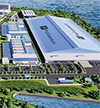Front Line: Extreme Weather Events Factor into Location and Sustainability Decisions
The risk of extreme weather events is increasingly being factored into companies’ location decisions, as are sustainability initiatives to reduce carbon emissions that contribute to global warming.
Q1 2022

Scientists say those kinds of extreme weather events are becoming more frequent due to global warming, which is just beginning to impact corporate site selection decisions. Exposure to natural disasters has always been part of the site selection equation, but it is becoming more front-and-center as a factor, says Didi Caldwell, president and founding principal of Global Location Strategies, a South Carolina-based consulting firm. “It has gained importance over the last 10 years and become even more prevalent in the last five years.”
Because of climate change factors, “We are seeing companies consider either relocation or building new capacity in areas they wouldn’t have considered previously,” Caldwell says. For example, a manufacturing plant based in Southeast Asia might be moved to a location that is less susceptible to hurricanes and rising seas caused by climate warming. “Companies are also bringing their supply chains closer to avoid some of the risks associated with international trade and locations,” she notes.
Lowering Carbon Footprints, Too
There’s also another side of the climate risk issue impacting companies: the increasing demand for “lower carbon” products and lower carbon footprints.
Internationally, the most visible example of climate risks affecting location choice involves major tech companies that are making data center location decisions based on access to renewable energy. “In this sector, it is already leading to some countries winning certain projects and others losing out,” said Dieter Billen, principal at consultancy Roland Berger, in a recent FDI Intelligence article. He cited data center projects in Vietnam and Africa where renewables played a major role. And, last October, both Google and Facebook purchased large parcels of land in Denmark for “potential” data center developments, drawn by access to renewables.
Environmental impact is beginning to play a more prominent role in facility design decisions, experts say, partly because consumers and business customers are increasingly demanding lower-carbon products and services. In the U.S., environmental impact (and its effect on global warming) is beginning to play a more prominent role in facility design decisions, experts say, partly because consumers and business customers are increasingly demanding lower-carbon products and services. For example, last year, Bendix Commercial Vehicle Systems completed installation of a 1.168-megawatt solar array at its large manufacturing plant in Huntington, Ind., decreasing its reliance on the local power grid and reducing the company’s carbon footprint.
The company says the Huntington solar array will contribute a 3 percent decrease to Bendix’s carbon footprint across North America. It will satisfy about 30 percent of Huntington Plant 1’s energy requirements and should decrease the campus’s carbon footprint by nearly 19 percent, Bendix officials contend. Moreover, in 2020, Bendix diverted 99.9 percent of its waste from landfills, and over the past six years, the company has reduced its energy consumption by more than 14 million kilowatt-hours.
Project Announcements
Australia-Based Aquatic Leisure Technologies Group Plans Opp, Alabama, Manufacturing Operations
12/11/2025
Teradyne Plans Wixom, Michigan, Robotics Operations
12/11/2025
Robinson Plans Altoona, Iowa, Manufacturing Operations
12/11/2025
BioTouch Expands Columbus, Georgia, Operations
12/11/2025
Natrion Plans Erie County, New York, Battery Components Operations
12/11/2025
Czech-Based GZ PrintPak Expands Mount Pleasant, Wisconsin, Manufacturing Operations
12/11/2025
Most Read
-
The Workforce Bottleneck in America’s Manufacturing Revival
Q4 2025
-
Rethinking Local Governments Through Consolidation and Choice
Q3 2025
-
First Person: Filter King’s Expansion Playbook
Q3 2025
-
Lead with Facts, Land the Deal
Q3 2025
-
How Canada Stays Competitive
Q3 2025
-
Investors Seek Shelter in Food-Focused Real Estate
Q3 2025
-
America’s Aerospace Reboot
Q3 2025


